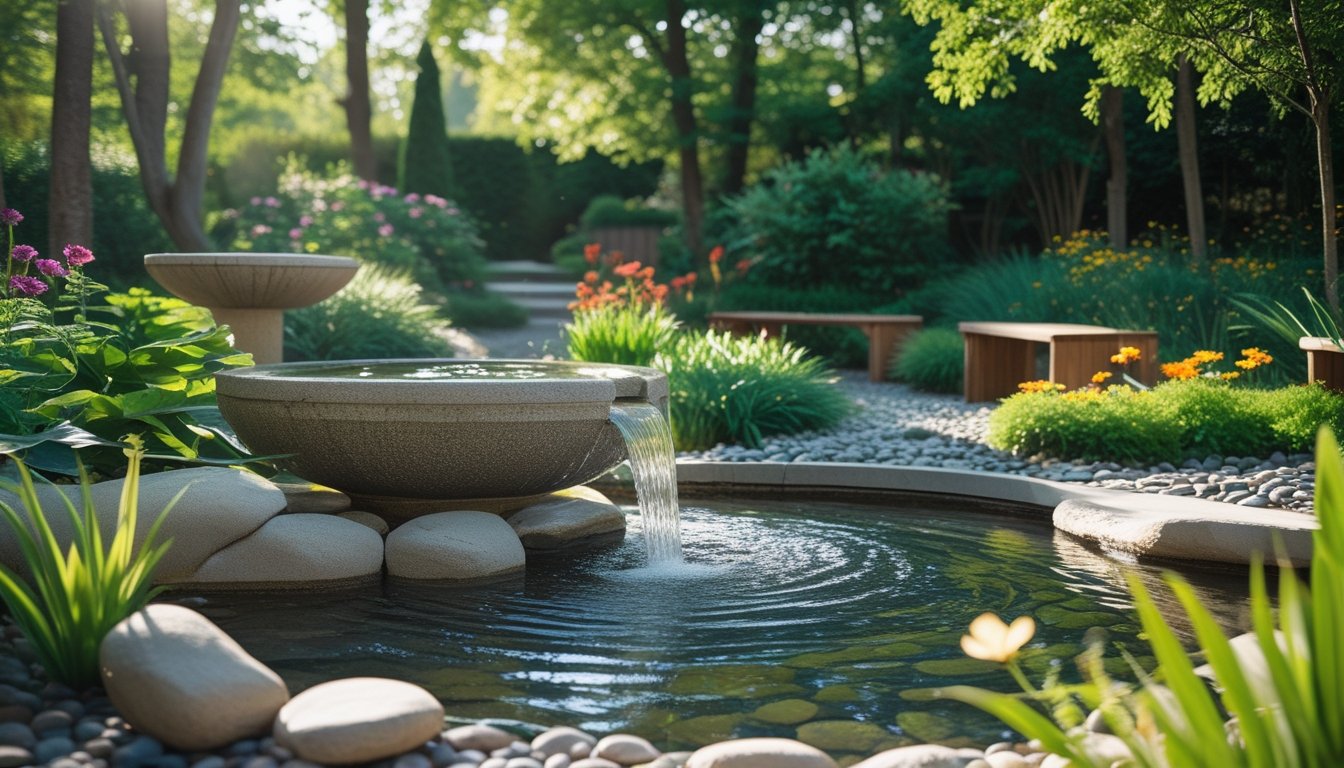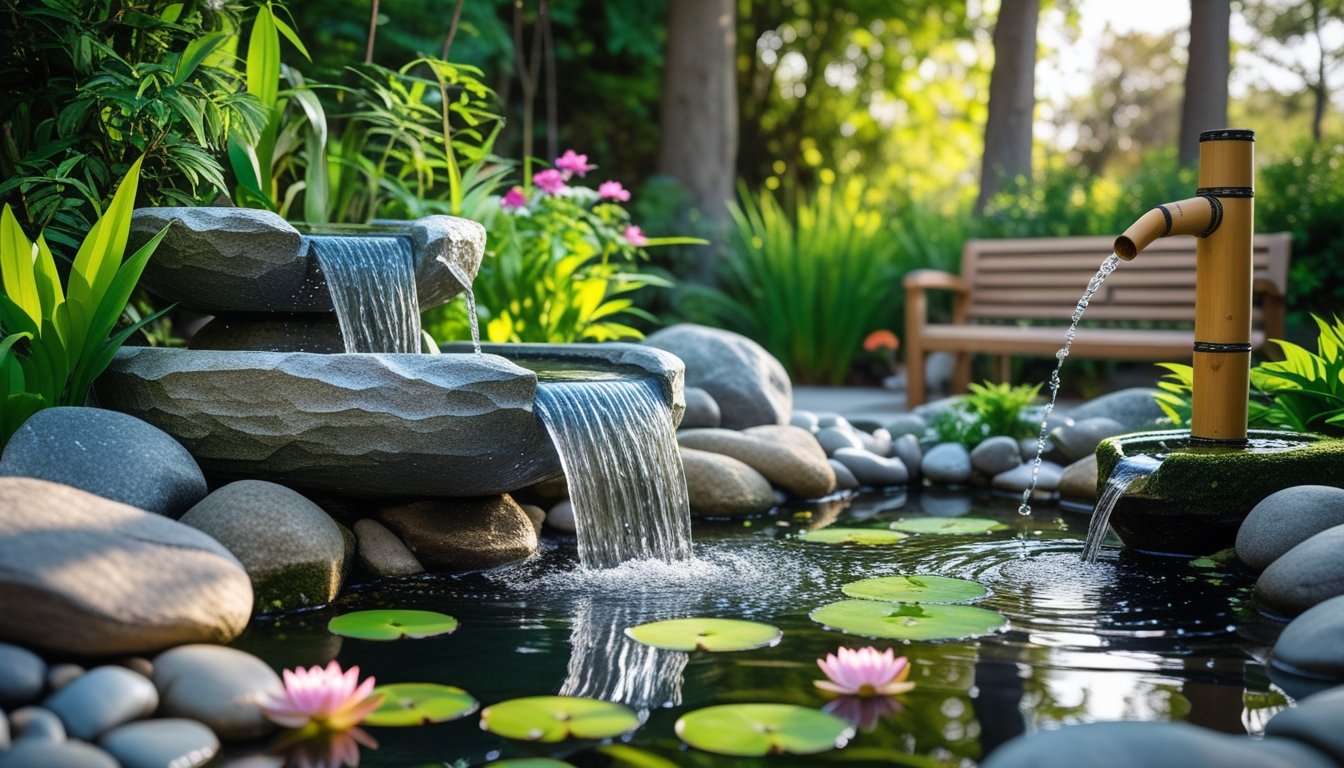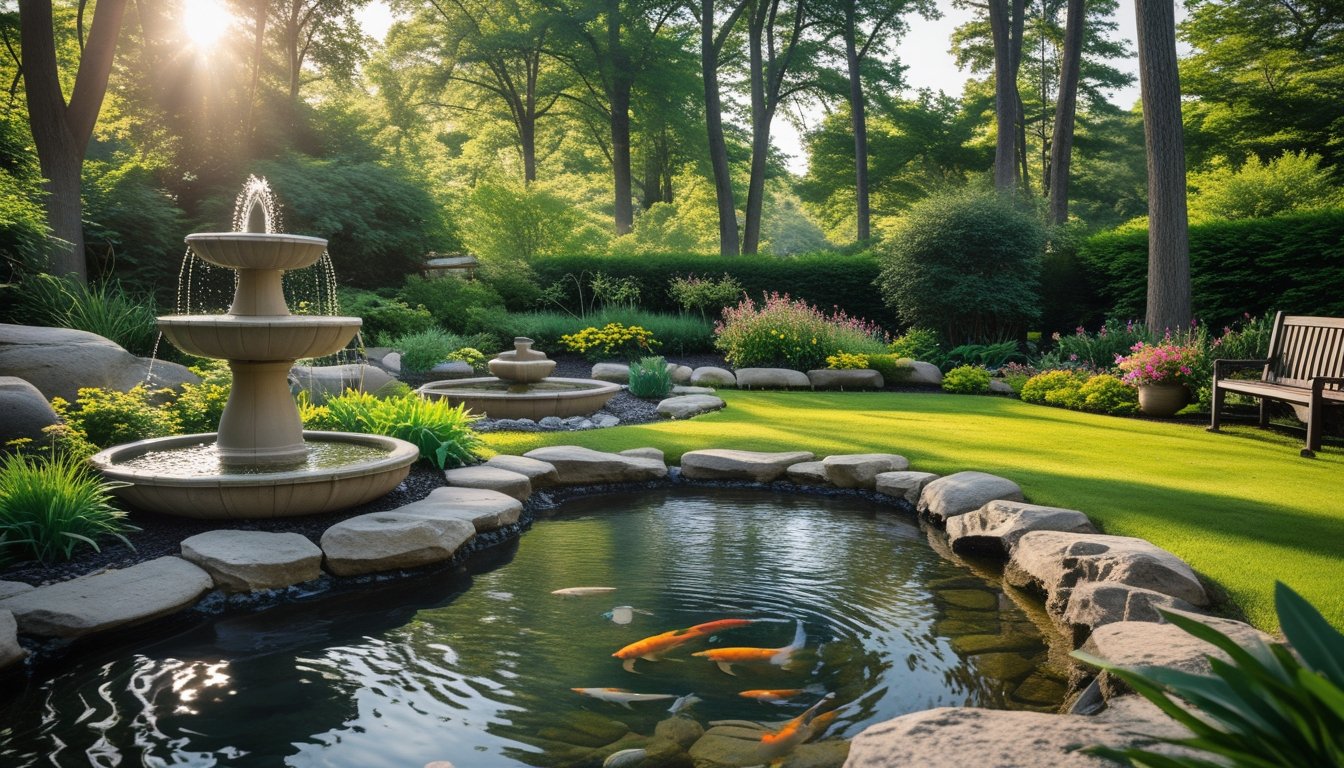Late updated: 26 Sep 2025 13:09
Written by: James Whitaker
Garden Water Features For Relaxation And Serenity: Enhancing Your Outdoor Space
Incorporating garden water features into our outdoor spaces allows us a unique opportunity to create personal havens of peace and reflection. The gentle trickle of a fountain or the stillness of a pond can transform even the smallest of gardens into spaces laden with tranquillity. By integrating water features into our garden design, we open a pathway to relaxation and retreat in our very own backyards.

Water features are not just about aesthetics; they are an invitation for nature to engage with our lives. They present us with serene sounds and sights that soothe the mind. From waterfalls to koi ponds, and elegant reflecting pools, each water feature offers its own special way to foster relaxation and rejuvenation in our gardens.
Exploring different water feature options empowers us to design a garden atmosphere tailored to our need for serenity. By understanding the potential of these features, we can craft our gardens into more than just visual treats but as sanctuaries for the soul.
Key Takeaways
- Water features offer peace and relaxation in our gardens.
- Selection of the right feature enhances garden atmosphere.
- Gardens become sanctuaries through thoughtful water design.
Key Water Features for Relaxation and Serenity

Incorporating water features into a garden transforms the space into a serene oasis. Whether it's the calming sound of flowing water or the visual appeal, water elements invite tranquillity and beauty into our outdoor areas.
Waterfalls and Water Walls
Waterfalls and water walls provide a stunning focal point that enhances any garden's atmosphere. The continuous flow of water creates soothing sounds, perfect for relaxation. Waterfalls can range from natural, rock-based structures to modern, sleek designs. When space or budget is a constraint, a vertical water wall is an excellent alternative.
These features mimic the natural cascading of water found in nature, adding unique character to gardens. By varying the flow rate or incorporating lighting effects, we can tailor the ambience to suit different times of the day. This versatility makes them a favourite among garden enthusiasts. Their ability to drown out unwanted noise further elevates the sense of serenity in any outdoor space.
Garden Ponds and Koi Ponds
Garden ponds offer a reflective surface that enhances the peaceful atmosphere, while koi ponds introduce lively elements. These ponds house colourful koi fish, providing aesthetic appeal and interaction. Implementing plants like water lilies or lotus flowers can complement the overall design, enriching biodiversity in our gardens.
Apart from their beauty, these ponds foster a rich ecosystem, attracting wildlife such as birds and beneficial insects. Koi ponds, in particular, require maintenance and an understanding of water chemistry to ensure the health of the fish. Despite the effort, the rewards are immeasurable as we create a tranquil retreat. Embracing nature through a garden or koi pond is a worthwhile addition to any outdoor space.
Fountains and Statue Fountains
Fountains, whether simple or ornate, serve as captivating centrepieces. Their design versatility allows them to fit varied garden styles, from classical to contemporary. Implementing fountains that feature statues or sculptural elements can add a touch of elegance and history, linking art and nature seamlessly.
The gentle splashing of water from a fountain brings a calming effect to the environment. We can adjust the water flow to achieve desired sound intensity, enhancing our relaxation experience. Placing a fountain in a strategic location, such as a garden entrance or patio, creates an inviting atmosphere for guests and residents alike. These features blend functionality and beauty, enhancing outdoor enjoyment.
Rain Chains and Rain Chain Basins
Rain chains offer a visually appealing alternative to traditional downspouts. As rainwater cascades through the chains, a gentle melody is produced, replacing harsh runoff sounds with calming notes. Available in various materials like copper and steel, rain chains can be customised to suit different garden aesthetics.
To maximise their appeal, incorporating rain chain basins allows water to collect playfully while reducing soil erosion. This addition transforms rainy days into an opportunity to appreciate nature's rhythms. Installing rain chains near patios or doorways enhances our garden's sensory experience, making rain not just a weather condition but also a source of relaxation and charm.
Designing a Serene Garden Atmosphere with Water Features
Creating a tranquil garden setting involves carefully selecting elements that promote relaxation and harmony. Incorporating features such as aquatic plants, lush greenery, and strategic lighting enhances the serenity offered by water features. Material choices like slate and granite can further elevate the sophistication and visual appeal of these spaces.
Aquatic Plants and Water Lilies
Aquatic plants and water lilies bring elegance to any garden. Water lilies, with their graceful floating leaves and vibrant blooms, offer a visually captivating display. They also play a vital role in maintaining a balanced aquatic environment.
Floating plants, like water lettuce, provide additional shade, reducing algae growth. These plants help maintain a clean and healthy pond. Together, they create not only visual splendour but also support ecological balance within the water feature.
Lush Greenery and Native Plants
Lush greenery contributes substantially to the overall aesthetic of a tranquil garden. Incorporating native plants enhances this effect, offering easy maintenance and resilience. Native flora supports local wildlife, adding an element of life to the garden.
Koi ponds become a focal point amidst greenery, where movement and colour add interest. Native plants also promote biodiversity, fostering a vibrant ecosystem that thrives alongside your water features.
Solar-Powered and Ambient Lighting
Solar-powered lights are both sustainable and practical, providing illumination without escalating energy costs. These lights can be placed around fountains or ponds, creating enchanting reflections and enhancing night-time enjoyment of the garden.
Ambient lighting highlights specific features like cascading waterfalls. Soft lighting sets a relaxing mood, while strategically placed lights enhance safety and accessibility. This combination makes evening garden visits a delightful experience.
Material Choices: Slate, Granite, and More
Choosing the right materials profoundly impacts the visual appeal and durability of water features. Slate and granite offer timeless elegance and blend well with natural settings. These materials are ideal for creating luxury landscapes.
Slate offers a rustic charm, perfect for modern or traditional designs. Granite, known for its durability, provides a polished finish. Using diverse textures and colours creates contrast and adds dimension, transforming the garden into a captivating retreat.
Frequently Asked Questions

Garden water features can transform outdoor spaces into peaceful retreats. We explore considerations for installation, maintenance tips, suitable plants, wildlife attraction, relaxation benefits, and safe electrical setups.
What are the essential considerations for installing a water feature in a garden?
Before installation, it’s crucial to assess the available space, water source, and aesthetic balance. Selecting the right type, whether a pond, fountain, or waterfall, is important for harmony with the garden's design. Evaluating the terrain and soil composition ensures the feature remains secure and functional.
How can I maintain a garden water feature to ensure its longevity?
Regular cleaning is vital to prevent algae buildup and debris from accumulating, ensuring water quality remains high. Monitoring water levels helps avoid damage from pump overwork. Routine checks of pumps and filters, removing dirt or blockages, promote efficient operation and longevity.
Which plants are best suited for incorporating around garden water features?
Selecting plants is key for a cohesive look. Aquatic plants like water lilies thrive in and around ponds. Marginal plants such as irises enhance edges with vibrant colours. Ferns and hostas, which favour damp soil, offer lush surroundings complementing water features.
Can garden water features attract wildlife, and if so, which types?
Yes, water features can attract various wildlife. Birds are drawn to fountains and birdbaths, providing opportunities for birdwatching. Ponds may invite frogs, dragonflies, and even beneficial insects. Diverse plant life around the feature also encourages a rich ecosystem.
What are the benefits of having a water feature in a garden in terms of relaxation and serenity?
Water features promote relaxation through soothing sounds and visual appeal. The gentle flow of water can reduce stress, creating a calming ambiance. Such natural elements invite mindfulness, transforming gardens into serene sanctuaries for mental well-being.
How can I safely set up electrical components for a garden water feature?
For electrical safety, ensure all components are weatherproof and designed for outdoor use. Employ Ground Fault Circuit Interrupter (GFCI) outlets to minimise risk. Cables should be buried or neatly secured to avoid hazards. Consulting a licensed electrician ensures a safe and compliant installation.
